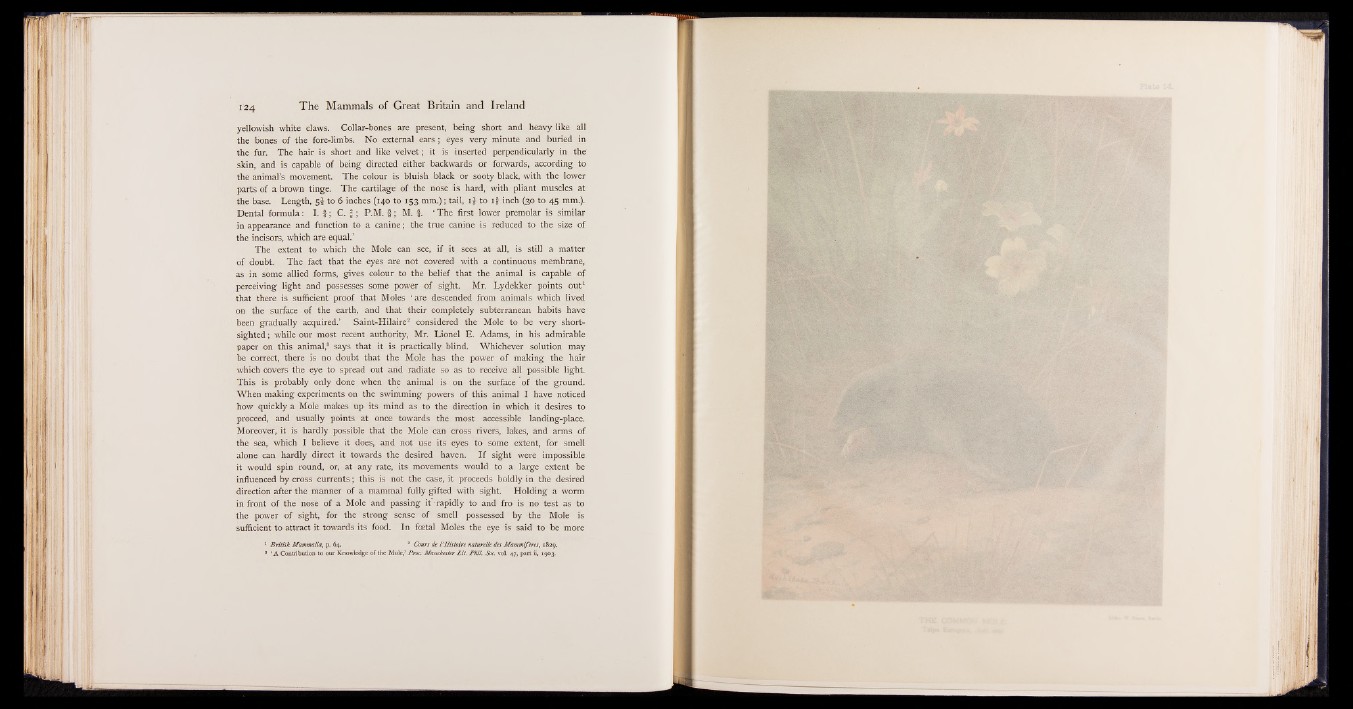
The 124 Mammals of Great Britain and Ireland
yellowish white claws. Collar-bones are present, being short and heavy like all
the bones of the fore-limbs. No external ears; eyes very minute and buried in
the fur. The hair is short and like velvet; it is inserted perpendicularly in the
skin, and is capable of being directed either backwards or forwards, according to
the animal’s movement. The colour is bluish black or sooty black, with the lower
parts of a brown tinge. The cartilage of the nose Is hard, with pliant muscles at
the base. Length, 5! to 6 inches (140 to 153 mm.); tail, i i to i f inch (30 to 45 mm.).
Dental formula: I. f ; C. f ; P.M. f ; M. f. ‘ The first lower premolar is similar
in appearance and function to a canine; the true canine is reduced to the size of
the incisors, which are equal.’
The extent to which the Mole can see, if it sees at all, is still a matter
of doubt. The fact that the eyes are not covered with a continuous membrane,
as in some allied forms, gives colour to the belief that the animal is capable of
perceiving light and possesses some power of sight. Mr. Lydekker points out1
that there is sufficient proof that Moles ‘ are descended from animals which lived
on the surface of the earth, and that their completely subterranean habits have
been gradually acquired.’ Saint-Hilaire2 considered the Mole to be very shortsighted
; while our most recent authority, Mr. Lionel E. Adams, in his admirable
paper on this animal,3 says that it is practically blind. Whichever solution may
be correct, there is no doubt that the Mole has the power of making the hair
which covers the eye to spread out and radiate so as to receive all possible light.
This is probably only done when the animal is on the surface of the ground.
When making experiments on the swimming powers of this animal I have noticed
how quickly a Mole makes up its mind as to the direction in which it desires to
proceed, and usually points at once towards the most accessible landing-place.
Moreover, it is hardly possible that the Mole can cross rivers, lakes, and arms of
the sea, which I believe it does, and not use its eyes to some extent, for smell
alone can hardly direct it towards the desired haven. I f sight were impossible
it would spin round, or, at any rate, its movements would to a large extent be
influenced by cross currents; this is not the case, it proceeds boldly in the desired
direction after the manner of a mammal fully gifted with sight. Holding a worm
in front of the nose of a Mole and passing it -rapidly to and fro is no test as to
the power of sight, for the strong sense of smell possessed by the Mole is
sufficient to attract it towards its food. In foetal Moles the eye is said to be more
1 British Mammalia, p. 64. 2 Cours de PHistoire naturelle des Mammifères, 1829.
8 ‘A Contribution to our Knowledge of the Mole,’ Proc. Manchester L it. P hil. Soc. vol. 47, part ii. 1903.